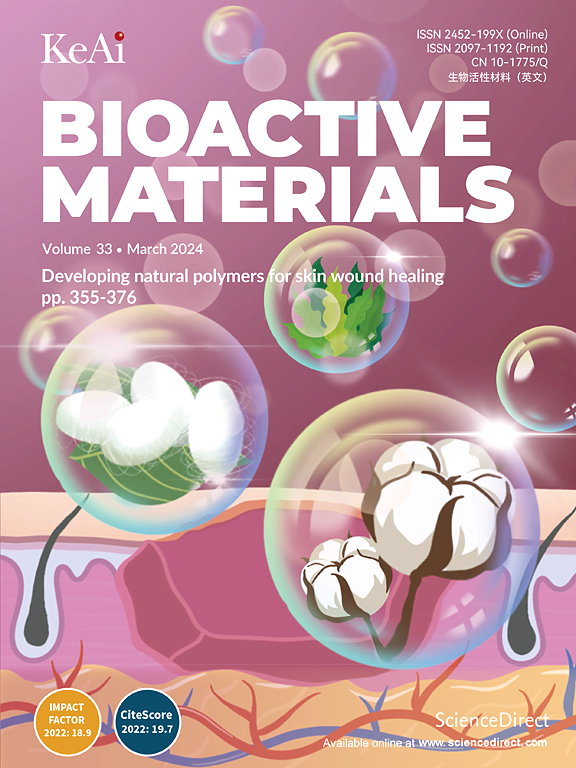一种保留胶质瘤微环境的新型类器官模型,用于个性化药物筛选和治疗评估
IF 18
1区 医学
Q1 ENGINEERING, BIOMEDICAL
引用次数: 0
摘要
神经胶质瘤是一种侵袭性脑肿瘤,预后不良。建立一种能够复制原肿瘤细胞组成和微环境的体外培养模型一直具有挑战性,限制了其临床应用。在这里,我们提出了一种从患者来源的胶质瘤组织中产生具有微环境(GlioME)的胶质瘤类器官的新方法。这些类器官维持原发肿瘤的遗传和表观遗传特征,并保持肿瘤微环境(包括常驻免疫细胞)内细胞间的相互作用。大量RNA测序、全外显子组测序和DNA甲基化分析被用来证实类器官和原发性胶质瘤组织之间的分子相似性。免疫荧光和流式细胞术用于评估免疫细胞活力,比较GlioME和漂浮胶质瘤类器官。GlioME表现出对化疗和靶向治疗的高反应性,表明其在治疗筛选方面的应用潜力。值得注意的是,GlioME准确预测了患者对最近批准的MET抑制剂vebreltinib的反应。因此,该类器官模型为胶质瘤微环境相关研究和临床药物筛选提供了可靠的体外平台。本文章由计算机程序翻译,如有差异,请以英文原文为准。

A novel organoid model retaining the glioma microenvironment for personalized drug screening and therapeutic evaluation
Glioma is an aggressive brain tumor with a poor prognosis. Establishing an in vitro culture model that closely replicates the cellular composition and microenvironment of the original tumor has been challenging, limiting its clinical applications. Here, we present a novel approach to generate glioma organoids with a microenvironment (GlioME) from patient-derived glioma tissue. These organoids maintain the genetic and epigenetic characteristics of the primary tumor and preserve cell-to-cell interactions within the tumor microenvironment, including resident immune cells. Bulk RNA sequencing, whole exome sequencing, and DNA methylation analysis were used to confirm the molecular similarities between the organoids and primary glioma tissues. Immunofluorescence and flow cytometry were used to assess immune cell viability, comparing GlioME with floating glioma organoids. GlioME exhibited high responsiveness to chemotherapy and targeted therapy, demonstrating its potential for therapeutic screening applications. Notably, GlioME accurately predicted patient response to the recently approved MET inhibitor, vebreltinib. Thus, this organoid model provides a reliable in vitro platform for glioma microenvironment-related research and clinical drug screening.
求助全文
通过发布文献求助,成功后即可免费获取论文全文。
去求助
来源期刊

Bioactive Materials
Biochemistry, Genetics and Molecular Biology-Biotechnology
CiteScore
28.00
自引率
6.30%
发文量
436
审稿时长
20 days
期刊介绍:
Bioactive Materials is a peer-reviewed research publication that focuses on advancements in bioactive materials. The journal accepts research papers, reviews, and rapid communications in the field of next-generation biomaterials that interact with cells, tissues, and organs in various living organisms.
The primary goal of Bioactive Materials is to promote the science and engineering of biomaterials that exhibit adaptiveness to the biological environment. These materials are specifically designed to stimulate or direct appropriate cell and tissue responses or regulate interactions with microorganisms.
The journal covers a wide range of bioactive materials, including those that are engineered or designed in terms of their physical form (e.g. particulate, fiber), topology (e.g. porosity, surface roughness), or dimensions (ranging from macro to nano-scales). Contributions are sought from the following categories of bioactive materials:
Bioactive metals and alloys
Bioactive inorganics: ceramics, glasses, and carbon-based materials
Bioactive polymers and gels
Bioactive materials derived from natural sources
Bioactive composites
These materials find applications in human and veterinary medicine, such as implants, tissue engineering scaffolds, cell/drug/gene carriers, as well as imaging and sensing devices.
 求助内容:
求助内容: 应助结果提醒方式:
应助结果提醒方式:


